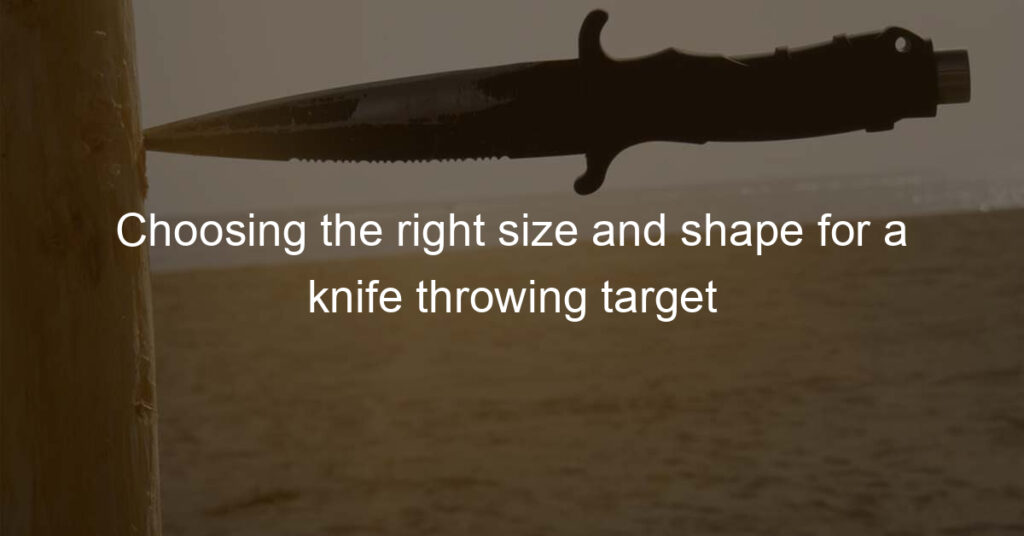Are you looking for the perfect knife-throwing target? Whether you’re a hobbyist or an aspiring competitive knife thrower, selecting the right size and shape of your target affects how well you can hone in on those bullseye shots. To make sure your aim is top-notch, it’s important to consider these features when choosing the ideal blade-catching board.
What’s the ideal size for a knife-throwing target?
When it comes to the ideal size for a well-executed knife-throwing target, good things come in small packages. It’s widely accepted that a target should be between 12 and 18 inches in diameter, although some experts prefer to focus on accuracy over distance and advocate for smaller targets as tiny as 6 inches wide.
Whether you go larger or smaller is completely up to you, just remember to make sure your knives have enough momentum to stick without them bouncing off the surface! Plus, if you’re limited on space due to set up outdoors or indoors, smaller sizes will help accommodate your environment.
What’s the best shape for a knife-throwing target?
Choosing the best shape for a knife-throwing target depends on your ambitions as a thrower. If you’re just looking for a fun backyard activity, any shape will do; however, for aspiring competitive throwers, a round or star-shaped target is recommended.
Round targets are considered easier to hit and help improve accuracy over time. On the other hand, those looking to up their game might find that star-shaped targets add an extra layer of difficulty in more challenging throwing sessions.
Whether you prefer traditional rounds or opt for something a little more dynamic, like stars and hexagons perhaps, it’s important to remember that knife throwing is all about practice and honing in on your skill set.
How to determine the right height for knife throwing?
Knife throwing can be a difficult skill to learn, so it is important to pay close attention to the right height. Typically, the ideal throwing height is determined by the length of your arm plus 6-12 inches.
This ensures that the knives won’t hit the board or floor while you throw. Make sure not to stand too close, as this will limit your angle and accuracy. To figure out the best height for you, try a few different distances and see which one produces more accurate results! With practice and patience, you’ll soon master knife throwing with ease.
Can I use different shapes/sizes for knife-throwing training?
Knife throwing can be an exciting and thrilling form of training – and the great news is that you don’t have to use a certain size or shape when it comes to practice. You can get creative and experiment with different shapes, sizes, weights, and even colors of knives until you find a type that fits your throwing style best.
Of course, ultimately you should always try to stick with regulation-approved throws for competitive purposes, but it’s totally fine to get creative in the comfort of your own home and test out what types work for you to become a whiz at knife throwing.
What’s the target’s distance from the thrower for knife throwing?
Knife throwing is an exciting skill to learn and master, but in order to hit the target accurately, you need to practice proper technique. Knowing the correct distance from the thrower to the target is key to success. Specifically, knife throwing should happen from a distance of 8 feet or farther away.
Though it may feel comfortable at first to stand closer, backing up further will improve accuracy over time. As you continue your practice and refine your skills, feel free to move a few feet closer until you understand distances better. With consistent practice and determination, knife throwing can become an enjoyable and rewarding hobby!
How to adjust the target size for different knives?
Adjusting the target size for different knives comes down to a few simple steps. First and foremost, you’ll need to decide how large or small of a target you’d like to work with.
From there, find an object big enough for the intended target and make sure it is stable so your knife can hit its mark without material shifting mid-throw. After choosing an object, mark out the target using something visible when using the knife.
Make sure to leave enough space around the edges as too close will hinder accuracy levels. With all of that taken care of, now it’s time to start practicing—remember to take safety practices into account and never throw a knife in an unsafe direction!
Conclusion
As you can see, selecting the right size and shape for a knife-throwing target is an important process. A smaller target might be better if you have limited space to throw, while a larger target may be more forgiving if you’re still learning how to throw accurately. When it comes down to it, it’s all up to personal preference and depending on why and how you plan on using the target.







